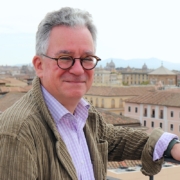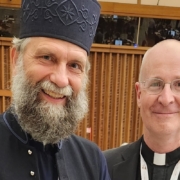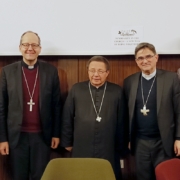Myriam Wijlens: The members of the church need to talk with each other
The Dutch-born professor of the University of Erfurt is not only participating in the synod, but also taking an active role in the preparation. At the end of the first session, we sat down to talk about cultural diversity, lonely bishops and wall-breaking walks.
– What is your task during the synodal process?
– In 2021, I was invited by Cardinal Mario Grech to participate in the work of the steering committee. I was the only woman in this team, along with three Italian priests and a bishop. From the very beginning of the synodal process, I actively participated in the preparation of the documents, I was present at the expert meeting preparing the continental phase in Frascati in September 2022, and at the European continental meeting in Prague in February 2023. In the meantime, Pope Francis appointed me as a consultor to the synod itself. I was also invited to participate in the first synodal session held in October 2023, where I assisted the assembly as an expert. There are four canon lawyers in this team: one of my colleagues, Péter Szabó arrived from Hungary, one person originates from Belgium and another from Spain. I was part of the English-language working group, and our task was to read the summaries of the discussions of the synodal members and examine on which topics there was agreement, where tension might have arisen, what issues require more theological deepening, and what further steps are needed.
– It seems that very active work took place during this session. Those who followed the event from a distance may feel that little of the expectations and desired renewal steps appear in the synthesis report issued at the end of October.
– We are witnessing a tremendous change. The synod itself is implemented in a completely different way than previous similar meetings. It had never happened before that the local churches were not told something from above, from Rome – now Pope Francis decided: you, the members of the local communities, will start the process. The first step was to establish mutual sharing and direct interaction between the local churches and the universal church. And when the dioceses sent their comments to the bishops’ conference, the focus was on whether the pastors had heard and understood well what the other faithful said. Clarification and feedback therefore played an eminent role. During the next step we wanted to enable the people in the dioceses to listen to what others in other parts of the world had said: in this way the faithful from e.g. Budapest could listen to the message of the faithful living in New York, Kinshasa, and Mumbai. This is what is expressed with the notion of being catholic as Vatican II articulated it.: each part of the church shares its own gifts with the others. This was the essence of our work in Frascati:
the representatives of the individual areas should not only tell their thoughts, but we should listen to each other, so that the voice of the Holy Spirit as heard through the whole church could reach everyone.
With this, everyone can explore how their own community can become a part of the symphony in a huge orchestra. Some people can play this or that instrument very well, but it is important to be tuned in the same way. And it is not enough to have a dialogue between the universal church and local communities, we must recognize that each continent has unique features. The Catholic communities of Asia, for example, have two thousand years of experience about how they can live together and be in contact with other religions that are the same age or even older than Christianity. Europe is characterized by the dominance of Christian culture, but our continent also has many differences in this regard. We therefore invited the Catholics of the world to listen to each other. I just published a book containing the results of all the continental conferences. It contains not only what the Catholics of the world formulated, but also how they arrived at the stated realizations. True diversity characterized the synod, in which we used the same method – conversation in the Spirit – that also characterized the continental councils. It was not by chance that we used round tables for the conversations instead of square tables, because in the latter case there is always one most important person who sits at the head of the table. The round table expresses a kind of Christian equality that based on our baptism. Another innovation is the fact that people from completely different cultures listened to each other. They did not preach to each other, but listened to each other. Everyone had the same amount of time to share their thoughts. And just as different communication cultures met – for example, we, Dutch people are outspoken, while a woman from Asia is more likely to being silent until she is given permission to speak – it is also true from an ecclesiastical point of view that some cardinals were very willing to speak, while some believers wondered: who am I, could I dare to comment? The rule that everyone had the same 4 minutes in the same sharing round helped ensure that those sitting at the tables heard each other.
– This was the first synod of bishops where lay people, including women, were given the right to vote, and their voices were heard in the same way as those of church leaders. How did the bishops and cardinals accept this new situation?
– I can tell you what I heard myself from the bishops who had participated in six or seven episcopal synods. They all expressed that the current method was quite different, because personal statements did not clash with each other, but they said all paid attention to what the Holy Spirit wanted to say to us about how to be a Church. I heard from many bishops how enriching this one month was for them, they got to know many new perspectives about the church. I think it was especially valuable to pay attention to the testimony of religious women, because they don’t just talk about the poor, they live there and serve among them. They live with the dying, those with rockets exploding overhead, who had to leave their homes. If anyone understands and knows the feelings of homeless, poor and needy people, it is the nuns. They live in a world that is foreign to many of us. I also hear about it, read about it, but I have no personal experience.
The participation of women in the synod and the hearing of their voices is extremely important because the majority of church communities are made up of women,
and we mainly meet them in the service of caritas. The obvious question arose for the bishops: how can we leave women out of such an important conversation?
– So the church leaders welcomed the presence of women in the synod session?
– I believe so, and the same is true in connection with lay men. There was, for example, an online communication expert who is familiar with the digital world. He communicated to us in what world the Church is operating or not operating while we can see how people are moving on the internet and what the church has to discover there. We are talking about a rapidly developing area where young people feel most at home, and bishops cannot avoid the question of how we can bear witness to our faith in an environment about which we currently know very little of. It is as if we are entering a new mission era, where we are not travelling from Europe to Africa, but are moving from the real world to the digital world. For this we must take the necessary steps. This requires appropriate media and communication training. You have to go where people are, because they don’t care where you are.
– The central theme of the current synod on synodality is the reality and function of the church itself. As our conversation shows, clerics and lay people used to live side by side. When I had a conversation with Cardinal Grech a year ago, it became clear that it is an important task to say goodbye to clericalism, religious selfishness, which can tempt lay people as well. This, however, would require much more dialogue, listening, and openness on the part of the members of both groups. I don’t know how common it is, but in Hungary a particular fear can be felt by the church leaders regarding the laity, while the laity do not really look for the possibility of dialogue due to a kind of disappointment. How can we break down these invisible walls?
– The first thing that comes to mind is how it struck me, when bishops shared their feeling of loneliness.
– Really?
– Yes, many bishops feel lonely. And they feel a lot of expectations that they are unable to meet. They should be present in the church as fathers and judges at the same time – the latter role arises, for example, in connection with abuses committed by members of the church. The mentioned clericalism is closely related to abuse issues. I was also a member of the Pontifical Committee for Protection of Minors between 2018 and 2022, I participated in 100 procedures, so I know quite well what I’m talking about. My answer to the question is that, because of all this, we must definitely find ways of dialogue.
We need to talk with each other. Sometimes it is difficult to sit down at the same table. But why can’t we walk, why can’t we literally walk together?
A trip, a pilgrimage, a walk together in which we ask each other: what about you, how are things going? In this way, we can invite each other to look together at the blisters that lie in our souls, to open up mutually to each other for help, for being served. I know that winter is coming, but even then we will surely find time, a nice afternoon, when we can organize a parish walk, a joint walk with the young people, to listen to them, priests can also walk with each other. The great thing about walking is that you don’t have to constantly look at the other person, and this situation often makes it easier to open up and listen to each other.
Written by István Gégény
Opening photo: Anthony Tynan-Kelly
You can reach the Hungarian translation here.






